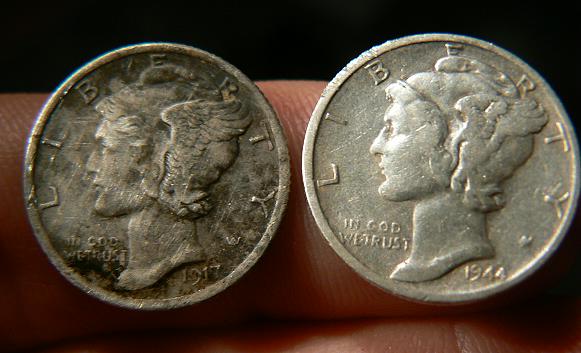Nor’easter dudded. They were calling for 4-8 inches in some reports, and we didn’t even get flurries. Hardly any rain either. If I were that bad at my job, I’d be out on the streets.
So, take advantage of an unexpected detecting day, and back to the field. Slow going for a while, fewer wheaties, and no silver until about 3 hours in, when I got a ’17 merc. Quite tarnished, but otherwise would prolly grade VF-XF. Interesting that at this site, all the silvers and wheaties/IH’s older than 1930 seem tarnished or badly abused, but those newer than 1930 are shiny and clean (even the wheaties, which is rare around here). Maybe around 1930 they stopped putting fertilizer on the field, or there was some other chemical event. Who knows? — I am certainly clueless about such things. I don’t even know if they used chemical fertilizer before 1930. Observing things like this, and thinking about them will occasionally lead to useful insight into the site — too bad it ain’t happening now.
One thing I discovered in the field today was an old road bed. Didn’t see it on any old maps, but I’m certain its very old. Last time I found a road bed in a field, I scored a barber half along it. I’m having my doubts about getting a big fish here tho; it is so quiet that such seems unlikely, but when I get to the old road, maybe the sound of the site will change and I will get lucky with that big fish.
With about 20 minutes left before I had to get back, I didn’t have enough time to do another rank along the field grid, so I worked on one of the loose end sections right by the supposed filled section; its just a 10 foot wide strip between that section and the field, awkward with trees, and right by a tree pops out a 44S merc, nice and shiny, at only 3 inches deep. Always be anal and clean up the loose ends at a good site, you never know.


I think you are spot on with the chemical event observation, but probably not fertilizer as that did not come into use per se until after WWII. But some defoliants and even organic fertilizers (chicken manure) might do it. Maybe it is the other way around, the soil in that area normally eats copper and tarnishes silver, the fertilizers used later on mellowed the soil and it was easier on the coins after that. I have a site where I have found no wheats in the hot zone (but 12 silvers, including 3 quarters; it wasn’t cleaned out by any previous hunters). It is an athletic field and whatever they use for fertilizer either eats copper or changes the signal to such a degree I don’t recognize it. Few nickels either, again the copper in them is affected. Outside that zone, lots of wheats. It is fun putting the pieces of these kinds of puzzles together.